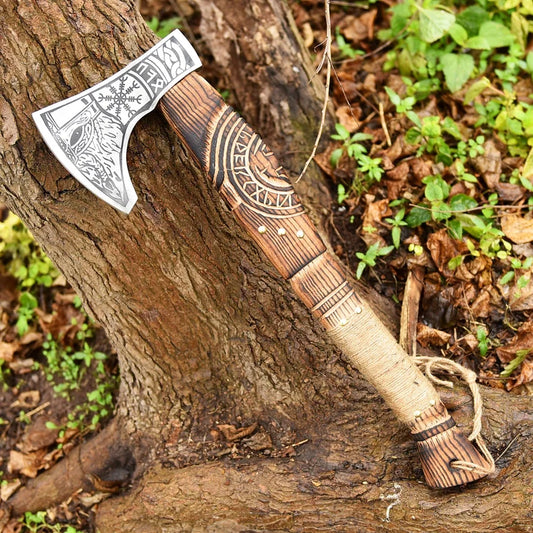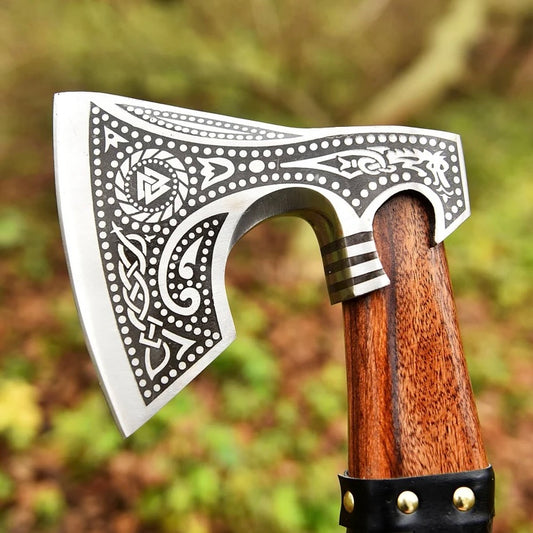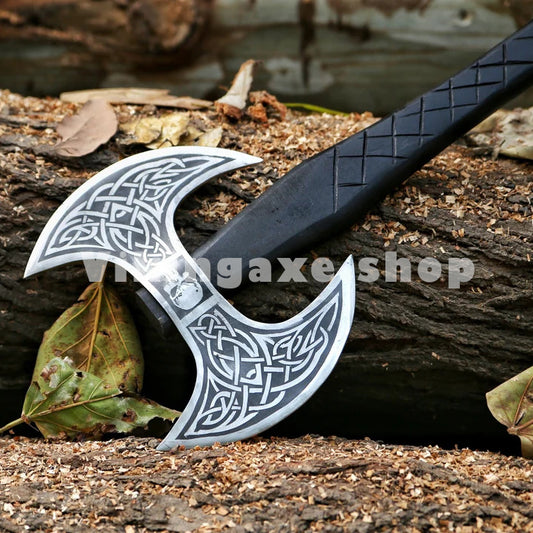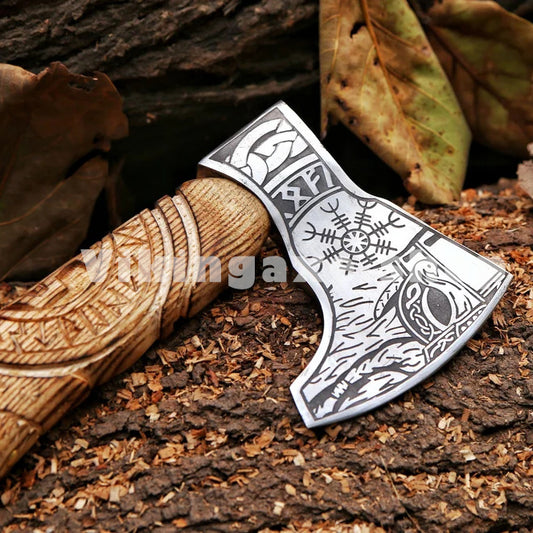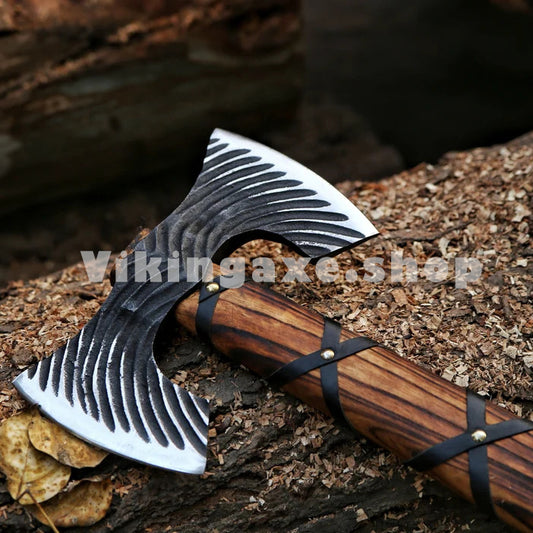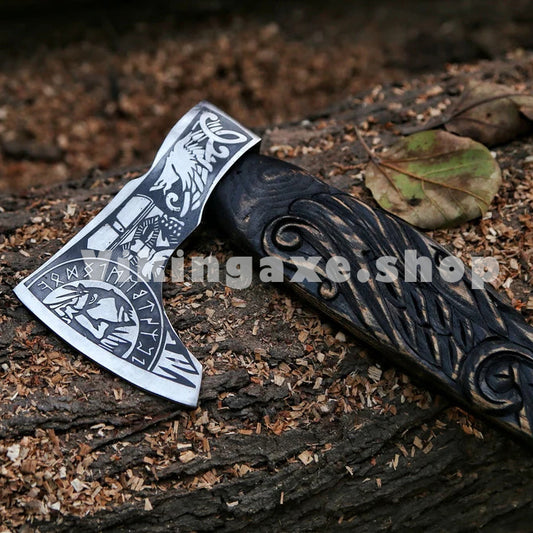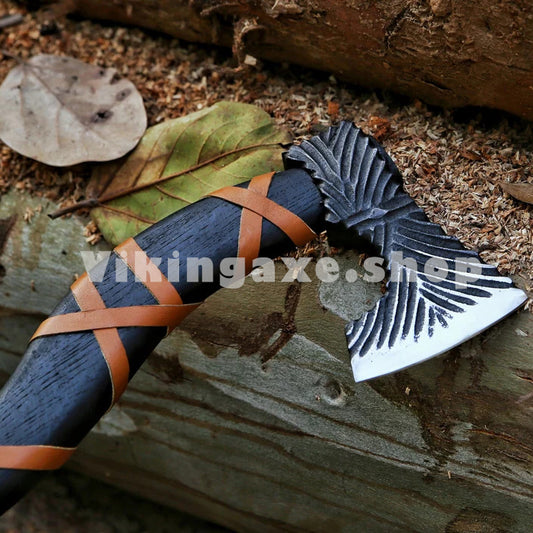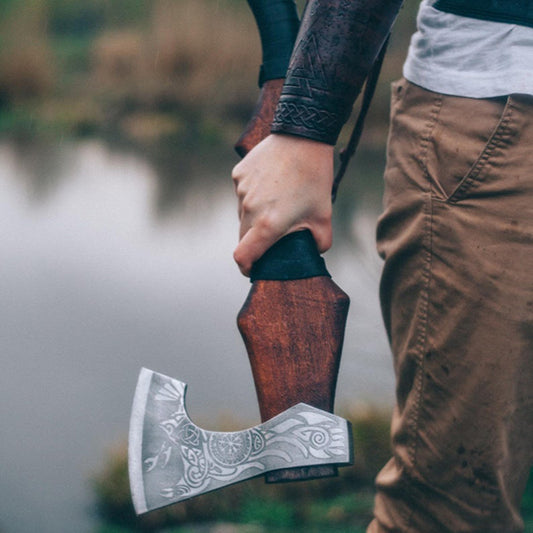
Viking Swords
Viking Swords: Unlocking the secrets of Viking Swords
Viking or Carolingian sword is a type of sword that was prevalent in Western and Northern Europe during the Middle Ages. The Viking sword was invented in the eighth century from the Merovingian sword and was the main sword used by the Vikings based in Scandinavia. The sword was taken from the Roman sword by Gladius. It is a one-handed sword with a sharp head and edges designed for cutting and pushing. Viking swords remained popular until the 12th century when they met with the Norman swords which were the first stages of the knightly sword.
Swords of the Forge offers you a variety of Viking swords that impress with your reading. Viking swords are often seen as large and intimidating with very long, thick blades. Their grip took both hands to allow for greater control and swing. These swords were used extensively for fighting but the idea was to keep your enemy away from you to prevent deadly injuries. The sheer size of these swords usually meant that they were heavy and difficult to maneuver, but their appearance often prevented war. Made of steel, these metal swords are often accompanied by scabbard (where noted). They vary in length but usually exceed three feet in length (arm reach) and hold well with pommel at the end. The Swords of the Forge believes in selling historically accurate, high-quality swords.
The Secret of Making Viking Swords
The modern-day swordsman is advancing the developers of the Middle Ages - a highly valued and feared sword. The Vikings were among the most fierce warriors ever to live, and the chosen few held the highest weapon: the sword almost a thousand years before its time. But the secrets behind the great sword design, creation and use have remained hidden for centuries.
The early Viking swords were made of pure metal, and were known to bend in battle. Later Viking swords, locally produced or purchased, were made by pattern welding, a complex process in which many small pieces of metal are assembled at high temperatures to form a solid blade. The trick is to create a suitable sword using this technique to spread different types of metal that balance stiffness and flexibility — it lasts long enough to hold the edge while pulling the contact shock. Scanned swords are not made in such a way that they can cut and bend.
However, it is difficult to draw conclusions about the performance of the metal sole. It was not until the eighteenth century that the true understanding of underground chemistry was developed. Apart from this knowledge the metal found in a particular metalworker, as well as the skill of that metalworker, had a profound effect on the blades produced.
Now, with a mixture of science, archeology, metallurgy and history, the joint production of NOVA / National Geographic is revealing the mystery and re-creating this Viking weapon - Ulfberht's sword.
One of the strangest things about Ulfberht's Viking sword is the strength of the steel. The materials used, known as “crucible steel”, are so sturdy and pure that it seems almost unimaginable that any metalworker of that time could actually carry them. In fact, since the years of Ulfberht, this quality of steel has not been seen in Europe for more than a thousand years. By the time Ulfberht's sword was made, however, similar weapons were being produced in the Middle East. The latter are made of so-called "Damascus metal", which comes from a raw material known as Wootz steel, and is from Asia. Both the Damascus metal and the molten metal have been found to contain an unusually high amount of carbon.
And the Norse people were not limited to home-grown industries. Rising far and wide in their natural state, Norse kings delighted to trade quality products and use them in warfare. The Vikings found swords in the Frankish empire, a tribal group based in Germany and Northern France that was famous for its metalworking.
Parts of Viking Swords
Viking swords consist of different parts, mainly the hilt and blade. The hilt is made up of following elements:
- Hilt
- Blade
The blade consists of a grip and a pommel, while the blade and tang form a single solid piece of metal as needed. The grip, in the form of holding plates for example, is attached to the tang with bolts or rivets.
Not only did the size and shape of the hilt sections vary with Viking-age swords, but also details of construction. Viking swords usually consisted of a pommel and a guard, although in some cases, both were made into a single piece. In some cases, the pommel was attached to the tang, and the top guard was tied to the pommel. several techniques, including
scribing and wire inlays.
The inlay was created by cutting a thousand small holes in the pommel metal, and then by assembling and striking small pieces of wire at the stations. The work is extremely tedious and time-consuming, but it results in an amazing look.
The handles were made of a variety of materials, from simple wooden branches wrapped in leather, to beautifully decorated handcuffs made of precious metal, or covered with engraved plates of precious metal.
At the beginning of the Viking era, blacksmiths could not make the right things for the sword, with the right amount and the right combination of structures. The Smiths made lumps from lumps of many materials: different types of metal with different properties, taken from different solvents. He selected the material he needed, then moulded it, twisted it, and then burned it to make a suitable sword. The process is called pattern welding.
In the past, it was believed that at least part of the difficulty was that the process of making metal was not properly understood or controlled during the Viking era.
Morphology
- Petersen (1919): Developed the first type of hilt typology of 26 species that is still widely used throughout Europe to distinguish and defy Viking swords. Based on the discovery of about 1,700 Viking swords in Norway [35] this type of language is always widely used. Types of Petersen is identified by the capital letter A – Z. Petersen wrote a total of 110 examples found in Norway. Of these, 40 were divided into two groups, 67 were solitary and 3 were meaningless.
- R. E. M. Wheeler (1927): Develop a simple type of sword blade based on British findings, including the Petersen type of hilt typology and blade typology, in nine types labeled I to IX.
- Oakeshott (1960): Added two other genres to the typology of the Wheelers closing the gap between the Viking Age and the recent mediaeval sword.
- Geibig (1991): introduces an additional type based on blade morphology (types 1-14) and pommel-type typology (types 1-17, with subtypes), focusing on the 8th- and 12th-century swords found within of Eastern borders. Francia (as it includes interim forms between the "Viking" and the "knightly" sword).
- Oakeshott (1991): Mainly facing the sword from the post Viking-age. He classifies all the swords of the Viking Age as his type X.
- Jakobsson (1992): recently published a detailed map of Petersen's sword-wielding patterns throughout Europe. Jokobsson's conclusions are discussed in Ian Peirce's 'Swords from the Viking Age'.
- Peirce (2002): Oakeshott provides a summary of species and discussion on carved blades. Jones also provides a summary of the hilt and blade separation, provides a summary of Jakobsson and Geibig's work and provides an updated date range of typology date chart. Peirce provides a catalog of examples, describing 85 or more complete swords and comparing them with Petersen's findings.
What was the best Viking sword?
Ulfberht’s sword was the best Viking sword ever. Now, with a mixture of science, archeology, metallurgy and history, the joint production of NOVA / National Geographic is revealing the mystery and re-creating this Viking uber weapon – Ulfberht’s sword.
Fashionable using a process unknown to Viking rivals, Ulfberht’s sword was a technological change and a work of art. It is considered by some to be the largest sword ever made, and it remains a fearsome weapon for more than a thousand years after the war ended.
But how did professional medieval swordsmen come up with the sophisticated Ulfberht method, and what was its role in history? So far, no one has been able to make Ulfberht metallurgically.Produced between 800 and 1000 AD, Ulfberht offered different advantages as a weapon. Its combination of power, light, and flexibility represented the perfect marriage of status and work in the chaos that was Vikinnotorious.
Since then thousands of Viking swords have been found, many of them found in rivers or excavated in cemeteries in Scandinavia and Northern Europe. Of those, only 171 were identified as Ulfberht – most of the only rusty bones ever seen – continue to hide the secrets of what some experts see as the ultimate weapon of fierce warriors.
Copied Viking Swords
Some of the best swords the Vikings could find came from the Rhine. Their blades had the name “ULFBERTH”, signifying the best swords of the day, made of high quality metal. Ulfberht may have been a craftsman who was responsible for the production of these swords in the Frankish Empire during the ninth century. However, swords were made until the 11th century, so the name should have been applied to certain workshop products.
Ulfberht’s swords became so popular that their exports had to be banned. This forced the Vikings to limit access to these quality swords, which they used most effectively to destroy the shores of the Frankish Empire. As a result, however, blacksmiths in the neighboring Frankish Empire began producing swords and copying the name ULFBERTH. Both the real swords and duplicates of ULFBERTH have been found in large parts of Europe. The simulations, however, tend to be of lower quality obviously than the actual models.
Features of Viking Swords
- The Viking sword was highly esteemed, because of its strength and characteristic – the quality of the sword was associated with the social status of the hero.
- The hilts were intricately decorated, and the two-sided navel (70-80 cm long) was remarkably curved and light, at the same time sharply sharp and sturdy.
- It so happened that swords were brought from France, but hats were made in Scandinavia, using ornaments related to Viking culture.
- The blade of the Viking sword was simple, flexible and very durable.
- Special sheaths were prepared .They were enriched with ornate handles, gold plated or brass in the open and at the ends.
- Viking swords were one handed weapon measuring 80-100 cm long. They had blades on both sides and equal, straight or slightly shorter to shorter, usually oval foible.
- Cross-Guard and Viking sword blades are one of the most decorated items throughout the history of cold steel.
- The weapons most often used by the Vikings and the real terror were swords, axes, and spears.
Culture
Swords were too expensive to make, and a sign of high quality. Having a sword was a matter of great respect. People of stature may have ornate swords emblazoned with silver names and inlays. Most Viking heroes could have a sword as one attack was usually enough to get a good weapon. Many freedmen may have a sword with goðar, jarls and sometimes the rich free with the most beautifully decorated swords. Poor farmers used an ax or a spear instead, but after a few raids, they would have enough to buy a sword. One sword mentioned in Laxdæla’s story was about half the size of a crown, or the size of 16 dairy cows. Manufacturing such weapons was quite an undertaking, and most swords were imported, such as the Rhineland. Swords could take up to a month to develop and were so valuable that they could be passed on from generation to generation. Often, the older the sword, the more valuable it becomes. Local artisans often added their elaborate hats, and many swords were named, such as Leg-biter and Gold-hilt.
As mentioned above, the sword was so highly esteemed in Norse society that good swords were valued for successive generations of heroes. There is even more evidence from the burial of the Vikings to “kill” swords intentionally and possibly, which involved the blade being bent so that it could not be used. Because the Vikings were often buried with their weapons, “killing” swords may have served two purposes. The traditional task of withdrawing a weapon from a warrior, as well as the actual task of preventing any grave robbers from disturbing the grave in order to obtain one of these expensive weapons. Indeed, the archaeological finds of fragile and broken metal swords still testify to the Viking ‘common burial of weapons, as well as the general “killing” of swords. Swords were not limited to the Vikings, but rather were used throughout Europe.
Viking Swords trafficking routes during the Vikings age?
The distribution of Frankish blades throughout Scandinavia and as far as the Volga Bulgaria attests to the great importance of the export of Frank’s weapons, though the Carolingian kings tried to prevent the export of weapons to potential enemies; in 864, Charles the Bald imposed the death penalty on arms sales to the Vikings. Ibn Fadlan in the 10th century makes it clear that the Vikings of the Volga carried the Franks’ swords. The Saracens invaded Camargue in 869 and demanded 150 swords as ransom for Archbishop Rotland of Arles.
Made in other countries, especially the Franks, weapons and armor played a special role in Norse society. Norsemen obtained trade (an extension of the gift to the Norse community) [citation needed] or as plunder. Therefore, their discovery and disclosure by any person could mean their position in the social order and any political allegiance they had. [19] [20] One example of an exchange of arms between the Franks and the Anglo-Saxons took place in 795 when Charlemagne exchanged arms with the Anglo-Saxon king Offa of Mercia.
Scandinavian ties in relation to foreign weapons and armaments during the Viking Age were very useful. Norse weapons designs were obsolete and iron ore in Scandinavia was of poor quality. Many of the Vikings’ most valuable weapons were beautifully adorned with gold and silver. Weapons of this type were used for religious and public activities. These precious metals were not manufactured in Scandinavia and were to be imported. Once in Scandinavia, precious metals would be placed on the pommels and spoons of arms forming geometric patterns, animal motifs, and (later) Christian symbols.
By the middle of the ninth century, there was an influx of these sophisticated weapons into Scandinavia, and the Franks’ arms became the standard for all Vikings. Of the Frankish type. “ Finally, in 864, King Charles the Bald of Western France sentenced the practice to death, and some scholars have suggested that such laws seemed so effective in curbing the flow of Frank weapons that they began a notorious attack by the Vikings.
Notable examples of viking swords
- Sæbø’s sword, the C-sword of the 9th century, discovered in 1825 writing in Sæbø, Vikøyri, Sogn province, Norway. The sword is notable for its blade-shaped design, translated as runic by George Stephens (1867), which may be quite unusual; while the Viking Age sword helmets were sometimes fitted with runes, inscribed blade inscriptions, with this possible variation, always in the Latin alphabet.
- One of the heaviest and longest surviving swords of the 9th-century Viking Age was also found in Flå, now housed in the Cultural History Museum, Oslo, 102.4 cm long and weighs 1.9 kg.
- Saint Stephen’s Sword: A Petersen T-10th century sword with walrus-tooth screen with engraved Mammen-style ornaments. It is depicted as the sword of the crowning king of Hungary Saint Stephen in the office of the Treasurer of St. Vitus Cathedral, Prague.
- Lincoln Sword (River Sword With): Swords of the 10th century, with a German / Ottonian-style razor blade classified as a separate version of Petersen L (Evison’s version of “Wallingford Bridge”) and the installation of helmets added by Anglo master Saxon, discovered at the Witham River in connection with Monks Abbey, Lincoln in 1848. [48] Peirce (1990) specifically mentions this sword as “breath-taking”, “one of the best Viking swords in existence”. [49] Lincoln’s sword is also noted for being one of only two well-known blades engraved with the word Leutfrit (+ LEUTFRIT), the other found in Tatarstan (then Volga Bulgaria, now housed in the Kazan History Museum). On the other hand, the blade is marked with a double scroll.
- Sword of Essen 10th century sword kept at Essen Abbey, adorned with gold planks at the end of the 10th century.
- The Cawood sword, as well as the Korsoygaden sword closely related, is remarkable in the context of describing “Viking Age swords” from the higher mediaeval genres; these swords fit well into the “Viking sword” type, but Oakeshott (1991) considers them to be extinct from the 12th century.
Conclusion
Viking swords were all dangerous weapons and fine works of art. As you can see from the replicas we offer, the heels were all used with one hand and the designs were very different. Some had straight guards, others bent over. Some had pumps with lobes of different shapes and sizes, others did not. Many of them were heavily decorated, usually with wire and fitted metal. These swords were much simpler and more accurate than many expected. The blades were double edged, but there was also a long sea across one. The first blades were patterned welded metal. Some swords from the Scandinavian sagas were considered magical. Like Gram, Sigurd’s sword. Originally a gift from Odin goes to the Volsungs, a sword used to kill Fafnir the dragon. The sword even pierced his side. Skofnung is the sword of the legend of Hrolf Kraki, known for being extremely sharp. Long after Kraki’s death the sword was taken from his mound and found to be in perfect condition.
